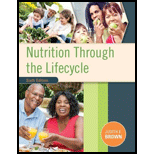
Nutrition Through the Life Cycle (MindTap Course List)
6th Edition
ISBN: 9781305628007
Author: Judith E. Brown
Publisher: Cengage Learning
expand_more
expand_more
format_list_bulleted
Concept explainers
Question
Chapter 3, Problem 11RQ
Summary Introduction
To examine: Whether the statement “Lois would have to exclude her diet sugar and foods containing sugar” is true or false.
Introduction: The high blood sugar that develops during pregnancy and mostly disappears after birth is called gestational diabetes. It develops at any stage of pregnancy and mostly develops in the second-half.
Expert Solution & Answer
Want to see the full answer?
Check out a sample textbook solution
Chapter 3 Solutions
Nutrition Through the Life Cycle (MindTap Course List)
Ch. 3 - Prob. 1.1CSCh. 3 - Prob. 1.2CSCh. 3 - Prob. 1.3CSCh. 3 - Prob. 2.1CSCh. 3 - Prob. 2.2CSCh. 3 - Prob. 2.3CSCh. 3 - Prob. 1RQCh. 3 - Prob. 2RQCh. 3 - Prob. 3RQCh. 3 - Prob. 4RQ
Ch. 3 - Prob. 5RQCh. 3 - Prob. 6RQCh. 3 - Prob. 7RQCh. 3 - Prob. 8RQCh. 3 - Prob. 9RQCh. 3 - Prob. 10RQCh. 3 - Prob. 11RQCh. 3 - Prob. 12RQCh. 3 - Prob. 13RQCh. 3 - Prob. 14RQCh. 3 - Prob. 15RQCh. 3 - Prob. 16RQCh. 3 - Prob. 17RQCh. 3 - Prob. 18RQCh. 3 - Prob. 19RQCh. 3 - Prob. 20RQCh. 3 - Prob. 21RQCh. 3 - Prob. 22RQCh. 3 - Prob. 23RQCh. 3 - Prob. 24RQ
Knowledge Booster
Learn more about
Need a deep-dive on the concept behind this application? Look no further. Learn more about this topic, health-nutrition and related others by exploring similar questions and additional content below.Recommended textbooks for you
 Nutrition Through The Life CycleHealth & NutritionISBN:9781337919333Author:Brown, Judith E.Publisher:Cengage Learning,
Nutrition Through The Life CycleHealth & NutritionISBN:9781337919333Author:Brown, Judith E.Publisher:Cengage Learning,

Nutrition Through The Life Cycle
Health & Nutrition
ISBN:9781337919333
Author:Brown, Judith E.
Publisher:Cengage Learning,




